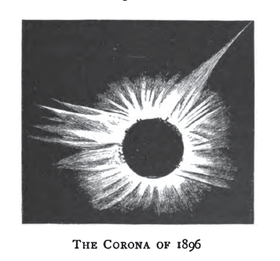Solar eclipse of August 9, 1896
| Solar eclipse of August 9, 1896 | |
|---|---|
 Map | |
| Type of eclipse | |
| Nature | Total |
| Gamma | 0.6964 |
| Magnitude | 1.0392 |
| Maximum eclipse | |
| Duration | 163 sec (2 m 43 s) |
| Coordinates | 54°24′N 132°12′E / 54.4°N 132.2°E |
| Max. width of band | 182 km (113 mi) |
| Times (UTC) | |
| Greatest eclipse | 5:09:00 |
| References | |
| Saros | 124 (48 of 73) |
| Catalog # (SE5000) | 9272 |
A total solar eclipse occurred on August 9, 1896. A solar eclipse occurs when the Moon passes between Earth and the Sun, thereby totally or partly obscuring the image of the Sun for a viewer on Earth. A total solar eclipse occurs when the Moon's apparent diameter is larger than the Sun's, blocking all direct sunlight, turning day into darkness. Totality occurs in a narrow path across Earth's surface, with the partial solar eclipse visible over a surrounding region thousands of kilometres wide. It was visible across Europe, Asia, and Japan.
Observations

Related eclipses
It is a part of solar Saros 124.
References
- NASA graphics
- Corona and Coronet: Being a narrative of the Amherst Eclipse Expedition to Japan, in Mr. James's Schooner-Yacht Coronet, to Observe the Sun's Total Obscuration, 9th August, 1896, by Mabel Loomis Todd, Houghton, Mifflin and Company, publishers, 1898
- Total Eclipses of the Sun, By Mabel Loomis Todd, 1894, new and revised edition by David P. Todd, 1900.
- Solar eclipse of August 9, 1896 in Russia
| Wikimedia Commons has media related to Solar eclipse of 1896 August 9. |
This article is issued from Wikipedia - version of the 10/20/2016. The text is available under the Creative Commons Attribution/Share Alike but additional terms may apply for the media files.
